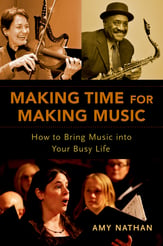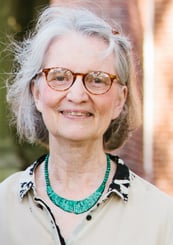There are more people who miss playing music than there are people who actually do play music. There are countless reasons for not going back to playing, including fear, lack of time, bad memories from childhood experiences, not knowing others who may be playing partners; the list is endless. The common thread running through all these stories is the regret most people express for no longer participating in an activity that they once enjoyed so thoroughly.
SHAR is so happy to be partnering with Associated Chamber Music Players to encourage people to get back into music making! For over 70 years, ACMP has passionately advocated for and led efforts to help people realize their dreams of getting back into playing with others. ACMP’s latest resource in this effort is author Amy Nathan . . . read ACMP executive director, Jennifer Clarke’s, interview with Amy Nathan, and how her new book, Making Time for Making Music (available at SHAR!) offers both inspiring stories, as well practical expert advice, in how you can get back into the most enjoyable and rewarding experience possible – making music with others!
Val Jaskiewicz
Editor's Note: The following Q&A transcript by Jennifer Clarke originally appeared on the Associated Chamber Music Player's website and is republished with permission. Click here to learn more about this organization and its members.
Making Time for Making Music - Amy Nathan Discusses Her New Book with ACMP
June 12, 2018
Amy Nathan's latest book, Making Time for Making Music:How to Bring Music into Your Busy Life is packed with stories of adult musicians' journeys back to music playing. Nathan's book tells of the benefits of music engagement as well as the many barriers that players overcome to enjoy playing music in adult life. ACMP is featured throughout the book, with more than 30 ACMP members quoted, many of them part of an Advice Team that participated in research for the book.
Nathan shared some comments about the book with ACMP Executive Director, Jennifer Clarke.
How did you come up with the idea for “Making Time for Making Music?”
In my two earlier books for Oxford University Press—one for young people and the other for music parents—I had always included a section on what I called “spare-time” musicians, people with non-music day jobs who still manage to fit music-making into their lives. But not everyone knows about the options available for non-pro musicians—not even people who are clearly interested in music.
Also sparking my interest were reports of neurological research showing that making music is good for your health, especially the brain, with tantalizing suggestions that playing a musical instrument might even delay some of the mental decline of aging. A Gallup Poll from 2009 showed that 85 percent of adults in the U.S. who don’t play a musical instrument wish they had learned to play one, and 69 percent would like to play one now. A 2012 National Endowment for the Arts survey showed that only 12 percent of U.S. adults were actually playing instruments.
Reading about other adults who have successfully carved out time for music might encourage others to give it a try. As an avocational musician myself—I play piano at home for fun and sing in a church choir—I was eager to learn more about the suggestions and strategies that successful non-pro music makers might have.
In this book, I try to avoid using the word amateur or spare-time musician to describe these non-pro musicians. The non-pro musicians I heard from in researching this book are very serious about their music. It may not be how they earn their living, but it’s central to who they are.
What were your goals and intentions in this book, and how well do you feel you achieved them?
One goal was to let the book’s readers know about a wide range of different ways that people without musical day-jobs manage to make music-making part of their lives. I assembled a large Advice Team of volunteers who would be willing to share their experiences with making music and who would offer advice and insights for others. More than three hundred non-pro musicians from around the US and Canada and a few from overseas joined the Advice Team by filling out the online questionnaire. About four dozen others joined the team by being interviewed by phone. The team consisted of more than 350 musicians ranging in age from 25 to 96, both instrumental and vocal musicians. Some were involved in classical music, others in jazz, folk, rock, pop, early music, and world music. The questions allowed Advice Team members to explain in some detail how they engaged with music.
How long do you spend researching before beginning a book?
For this book, I spent several months researching the world of avocational musicians before creating the online questionnaire and sending it to potential members of the book’s Advice Team. I plan to write follow-up blog articles on topics related to the book that will appear periodically on the Oxford University Press Music Blog.
What was the hardest part of writing this book and what did you enjoy most about writing this book?
The toughest part was not having enough space in the book to quote everyone who filled out a questionnaire or was interviewed by phone. Everyone made such thoughtful comments and observations. The part I enjoyed the most was getting to know all these fascinating musicians and hearing their stories.
What is the most important thing that people DON'T know about your subject, that they need to know?
There are several things that many people don’t realize about avocational music-making: that just about anyone can learn to sing; that it is possible to learn to play a new instrument as an adult, even over the age of 60; and that even parents of young children are finding ways to stay involved with making music. There are support groups that can provide needed encouragement and helpful tips for adults trying to get back into making music, such as music Meetup groups, beginner-friendly ensembles, music school workshops, and also ACMP, which helps connect people to play chamber music together.
If you could summarize the most important message carried in the book, what would it be?
You’re never too old, or too busy or too rusty to make music, that people can make music at any age, and that all of us who do make music are musicians, from the struggling beginner to the polished pro.


Left, Making Time for Making Music; right, author Amy Nathan




